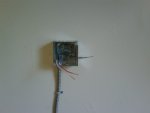jxofaltrds
Retired ESI
- Location
- Mike P. Columbus Ohio
- Occupation
- Creator
There has been ranges and dryers that have neutral loads for long time. Ranges usually had at very least a 120 volt oven light, and maybe a 120 volt timer or clock. Dryers almost always have had 120 volt motor and 120 volt control timer, and sometimes a 120 volt light inside the drum. When you do run into one of these appliances with no neutral load they still have a neutral terminal on the main power block - I suppose partly because most of them will still have a 125/250 volt cord cap installed on them and that gives you a place to land the neutral even though it isn't needed.
The if new appliances require a neutral should they be required to be changed to a 4-wire system or be allowed to be connected to the 'grandfathered' 3-wire?
I fully understand that, very likely why I put 'NM' in my post.
I know that we used NM in the early 90's for dryers when I was a helper bee!




